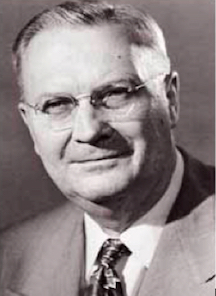Sidney B. Sperry
Sidney B. Sperry was a biblical scholar and the first member of The Church of Jesus Christ of Latter-day Saints to become a fully trained theologian.
Sperry was born on December 26, 1895, in Salt Lake City. While a teenager, he heard that the Reverend Franklin S. Spalding was trying to discredit the Book of Abraham in the Pearl of Great Price and he decided that one day he would “defend the latter-day scriptures he saw under attack.”[1]
He graduated from the University of Utah with a bachelor’s degree in chemistry and worked for two years with the U.S. Bureau of Metallurgical Research. He then served a full-time mission for the Church in the Southern States Mission until 1921.
In 1922 he began working with the Church Educational System as a Seminary and Institute instructor. He had numerous conversations with Elder James E. Talmage who encouraged his plan to obtain a PhD in biblical studies and learn the ancient languages that would shed light on the scriptures. Sperry went on to receive his master’s degree and PhD in Old Testament languages and literature from the University of Chicago. He also pursued postdoctoral work as a university fellow at the American School of Oriental Research in Beirut and the Hebrew University in Jerusalem. At this time he considered that he might have the largest impact by being a Latter-day Saint scholar out in the world and thought about staying somewhere in the east at a larger university. But one night he had a dream that pointed him to Brigham Young University.
- He saw a veritable Mecca of learning—multistory buildings, tens of thousands of students, world-class professors and facilities. The buildings were tall and light colored, and appeared white. He saw concourses of students from all over the world. In his own words:
- “I was up high, looking down on the foothills of Y mountain, but it was a time farther in the future. The campus I saw was not the tiny cluster of buildings I had known, but a great array of many, many buildings. I was amazed at Brigham Young University, and I thought, “How much is going on in those buildings, with thousands of students and teachers, and much research. What a power for good it is!
- “Then I scanned the foothills and saw that the university spread northward, with many more buildings, and most of the structures were white. They reached the point where they adjoined a white temple, and I thought, ‘So we will have a temple!’”[2]
Sperry joined the faculty of BYU in 1932 and believed in his vision of BYU despite the probability of the university being shut in the wake of the Depression with university funds consequently diminishing. Church leaders did not shut the doors of BYU.
He persuaded the university administration and the Brethren “that ‘there needed to be a core of people that were trained’ at the highest academic levels in matters of the Old and New Testaments (as well as an understanding of the milieu out of which all of the standard works came and their doctrines).”[3]
From 1948 to 1954, Sperry served as the director of the Division of Religion and from 1954 to 1959 as the director of Graduate Studies in Religion at BYU. He pioneered the Study Abroad program and was a popular speaker at the BYU Know Your Religion and Education Week programs. Hugh Nibley called him the “‘Grand Old Man’” of religious education who had the rare attribute of unshakable faith.”
He authored eighteen books, including Our Book of Mormon, The Voice of Israel’s Prophets, The Spirit of the Old Testament, Paul’s Life and Letters, Doctrine and Covenants Compendium, and the Book of Mormon Compendium. He was given the Karl G. Maeser Distinguished Teaching Award in 1962. He retired in 1971.
Since 1973, the annual Sidney B. Sperry Symposium is held at BYU, and an accompanying volume of the proceedings is published by the Religious Studies Center and Deseret Book.
Sperry and his wife, Eva, were the parents of eight children. He died on September 4, 1977.
